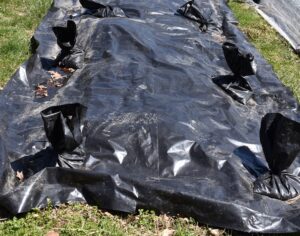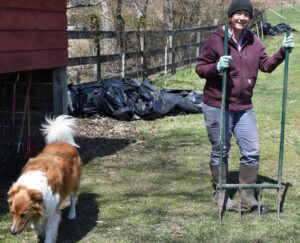Hello fellow readers, Last week, we learned about No-till Gardening thanks to Patti Doell of Little Big Farm. She began using the system for her flower farm three years ago and has remarkable results of improved soil, fewer weeds, and increased bounty. I asked if a homeowner wanted to start a new no-till garden, where they have a lawn now; what does she suggest?
There’s no need to remove the grass before starting a no-till garden.
Whether the garden will be for flowers, vegetables, or shrubs, rather than the laborious task of removing the grass, Patti said she would tarp it first. “And if you can’t find a tarp, I’d use cardboard.”
What a great idea! Especially since many of us have plenty of cardboard from online shopping. Or, you can use black plastic sheeting (4 mil or 6 mil).
“You don’t want light or air to get in there. So, if the plastic or cardboard is tight, with something to hold it down, it doesn’t take as much time.”
The Process of Occultation:
The process of removing light and air to control weeds or kill turf and plants is called Occultation. The University of Minnesota explains, unlike Solarization using clear plastic that allows light and heat to pass through (a greenhouse effect), the black sheeting used in Occultation absorbs the light, therefore not heating the soil as much. Occultation takes four weeks to be effective, and after six weeks, the efficacy wears off.
Ideally, they say to bury the edges of the plastic to keep it from blowing away while keeping the air out. Patti uses sandbags or rocks. Or, you can use landscape staples—u-shaped pins used to anchor irrigation tubing. They’re also used to secure landscape fabric. A side note here—I never suggest landscape fabric in a garden other than below gravel as it causes shallow roots and poor plant health. Plus, weeds form anyway as the mulch on top breaks down.
Patti explained Occultation doesn’t hurt the microbial life; “they go deeper in the soil. And when you take it off, they come back into the topsoil.”
You don’t have to remove the dead grass either, “Just use the broadfork, add about an inch of compost, and plant.”
The advantages of using cardboard in starting a No-till Garden:
“What’s nice about using cardboard instead of plastic is you can just put it down and add compost or grass clippings on top to keep it in place. Let it sit for a couple of weeks or months if you have more time,” Patti said.
And, a drum roll, please—Patti suggests if your new garden is in the front yard, you can just put compost on top of the cardboard and plant annuals right on top of it.”
What a great idea! An instant garden. It only takes a couple of months for the cardboard to break down. “You don’t need to lift it up either. It just disappears.”
Patti will then plant a fall cover crop in the new garden, and just before winter, she’ll lay down a tarp. Come spring, she’ll remove the tarp, broadfork the soil, add compost, and plant.
“Are there chemicals in cardboard to be concerned about?”
“Don’t use colored cardboard, only brown corrugated. And it’s nice to take the tape off, but I don’t always get to that.” Worms love cardboard,” Patti explains. “It may be the glue.”
And, another drum roll, please—Patti puts cardboard down in the pathways of her vegetable garden and adds mulched hay on top. Be sure to get the mulched hay from a reputable source; otherwise, you’ll get weed seeds.” Or hay treated with pesticides.
Straw is also an option. Which brings a question, what’s the difference between hay and straw. And, what are the pros and cons of each in the garden? I feel another column coming on :^). Garden Dilemmas? AskMaryStone@gmail.com (and your favorite Podcast App.)
Click through to last week’s column on No-till Gardening explaining broad-forking.
This story is featured in Episode 28 of the Garden Dilemmas Podcast on wherever you get your podcasts or the link below:
The University of Minnesota Extension has a great article on using the sun’s energy to kill weeds.




